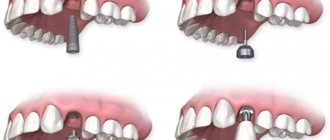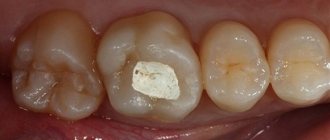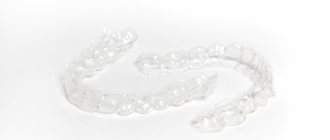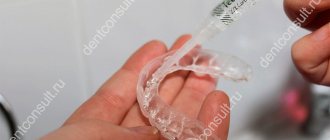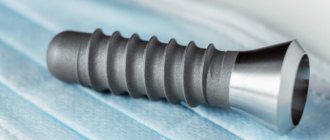15786
The absence of one or more teeth is a problem that can be easily solved with the help of prosthetics. But any method of restoring teeth is a very expensive and time-consuming procedure.
As an alternative method, metal-plastic crowns are often used, the cost of which is significantly lower than other options .
What are they?
A metal-plastic crown completely replicates a natural tooth in appearance and shape. The structure is a metal frame with a plastic lining.
This type of crown is used for immediate prosthetics and is installed for a short period of time , since the plastic lining does not tolerate constant mechanical stress. With their help, either one tooth or an entire group can be replaced.
Photos of metal-plastic crowns
A metal-plastic crown allows you to protect the tooth after grinding until a permanent coating is installed. In addition, a timely installed metal-plastic prosthesis prevents resorption of the alveolar bone at the site of the lost tooth.
Dentists recommend installing such coverage only for 1–3 months . But due to the low price, many insist on using crowns as a permanent structure, despite the material's susceptibility to rapid deformation.
When using metal-plastic dentures as a permanent structure, the risk of caries and periodontal diseases increases several times .
Don't know which crowns are best for your teeth? Our article will help you make the right choice.
In this publication we will talk about the purpose of the Butterfly temporary denture.
Here https://www.vash-dentist.ru/protezirovanie/nesemnyie-p/koronki-np/keramicheskaya-na-zub-opisanie-vidov-dostoinstva-tsenyi-i-otzyivyi.html we will discuss how much a ceramic crown can cost per tooth
Advantages and disadvantages
Like all other prosthetic methods, metal-plastic construction has its advantages and disadvantages.
The advantages of such coverage include the following::
- speed of installation . Dental offices often have ready-made template crowns that are installed immediately after preparing the tooth;
- versatility _ The materials used make it easy to create both a single crown and a bridge prosthesis of a removable or fixed type;
- ease of manufacture . If necessary, the product is manufactured in 1-2 days;
- no trauma . Installation takes place with minimal risk of damage to the mucous membrane, therefore it is recommended for people with highly sensitive gum tissue;
- reliability of fastening . The lightness of the plastic and the strength of the metal allow the prosthesis to fit well on the teeth.
At the moment, metal-plastic is the most budget option for prosthetics. In this case, all functions of the dentition are completely restored.
Despite all the positive aspects, such prostheses also have some disadvantages :
- plastic cannot always convey the desired shade of natural teeth;
- cladding tends to change its color over time under the influence of coloring products;
- To obtain the natural color of the crowns, the plastic is applied in a thick layer. To prevent such a crown from looking too voluminous in the overall row, the tooth being restored has to be heavily ground down ;
- The plastic coating and the metal frame have poor adhesion to each other, so chips often form under mechanical stress .
To choose the best option, we suggest using the comparative characteristics of crowns made of metal-plastic, metal-ceramics and metal-free ceramics given in this table:
| Characteristic | Metal ceramics | Metal-free ceramics | Metal-plastic |
| Price | 4-15 thousand rubles. | 8-17 thousand rubles. | 3-5 thousand rubles. |
| Life time | 15 years | 10 years | up to 3 years |
| Presence of contraindications | No | No | Yes |
| Restoration of one tooth | Yes | Yes | Yes |
| Restoration of a group of teeth | Yes | Yes | Yes |
| Possibility to change color | No | No | Yes |
| Possibility of chipping | No | No | Yes |
| Installation for weakened gums | Yes | Yes | No |
| Age restrictions | No | No | Yes |
Analyzing the data in the summary table, we can conclude that metal-plastic is the least quality material used in prosthetics .
In any case, only a dentist can judge the advisability of installing this product.
Advantages and disadvantages of metal-plastic crowns
The advantages of metal-plastic crowns are:
- low cost compared to other types of implants;
- repair of the prosthesis can occur directly in the oral cavity (the most common damage is the chipping of part of the plastic covering, which can be corrected without removing the implant);
- low degree of deformation of adjacent teeth (compared to all-metal crowns);
- reliable fixation thanks to the metal base.
Metal-plastic crowns also have a number of disadvantages, for example:
- Fragility. Prostheses of this type last from 2 to 5 years, after which they must be replaced with new or more durable ones.
- Lack of aesthetics. Compared to ceramic or zirconium crowns, plastic does not have natural transparency or a wide range of colors, and can also absorb dyes and change color.
- Fragility. Plastic tends to chip and wear off.
- Allergenicity. Plastic or metal alloy may cause an allergic reaction in the patient.
How long will they last with proper care?
Low resistance to the impact of the covering material and its poor adhesion to the metal frame determine the wearing period of crowns, which often does not exceed 2 years .
According to reviews, with good care this period can be extended by 5 years, but no more. In this case, a significant change in the color of the structure and slight deformation are observed.
The minimum wearing period guaranteed by dentists is 2-3 months..
In order for metal-plastic crowns to last as long as possible, you must adhere to certain care rules :
- Brushing your teeth should be done not 2 times a day, but every time after eating. This is due to the porosity of the material, which is able to quickly absorb and retain pathogenic microorganisms;
- it is necessary to avoid food products containing dyes, as the crown will lose its natural color;
- Do not use a brush with hard bristles for cleaning. It leads to abrasion of soft plastic and its surface becomes uneven;
- It is necessary to use dental floss to clean the interdental space;
- The edge of the crown wears out over time and can injure the mucous membrane, causing inflammation. Therefore, visiting the dentist should be regular;
- In addition to local care, it is worth adding multivitamin therapy, which improves immunity and is a good prevention of periodontal diseases.
These rules are fundamental. By following these tips, you can significantly extend the life of your prosthesis.
Kinds
A solid metal crown can be made from different materials.
Such products can be:
- metal with spraying,
- without spraying,
- with lining,
- combined bridge prosthesis.
The design without coating does not look very aesthetically pleasing; it is made of polished metal. It has a relatively low price, but not everyone is happy with it.
If aesthetics are important to the patient, then you should choose a crown with a coating that imitates gold. They look more attractive, but you should be careful when spraying: it can have a negative effect on the mucous membrane.
A one-piece crown with ceramic lining is perhaps the most aesthetic option of the three already presented - it has an overlay made of ceramic or plastic, which is located on its front surface. Of course, the pad also needs to be treated with care, because it is made of fragile materials, but if you follow the rules of care, it will last a long time.
A combined prosthesis is created from several metal-ceramic crowns that cover the smile area, and from solid polished crowns.
Manufacturing Features
The installation of metal-plastic dentures is carried out both on the day of grinding the teeth, and several days later, after the preparatory procedures. This will depend on the type of crown manufacturing.
Currently two types are used :
- Stamped .
They are manufactured in advance, in the form of universal template blanks. Next, softened plastic is applied to the metal frame, which hardens under the influence of a special lamp. The advantage of this type of dentures is that they are always available in the dental office. But they also have a drawback: the uneven edge of the structure does not fit tightly to the gum line, which can provoke the development of caries. - Cast. Their creation goes through all stages of laboratory manufacturing: individual casts and a wax model are used, from which a metal frame is cast.
In this case, the patient’s wishes to use non-standard material as a base are taken into account: precious metals, an alloy of cobalt and chromium.Also, if desired, the plastic coating can be applied only to the outer part of the product. In terms of aesthetics and safety of use, this option is preferable to the first, but it is worth considering that production takes several days.
Contraindications
The composition and structural features of this product determine its contraindications, in which use should be excluded :
- pathology of periodontal tissue in severe form;
- allergic reactions to plastic and metal;
- malocclusions of 2 and 3 degrees;
- bruxism;
- shortening of the mandibular incisors;
- vestibular deviation of teeth;
- incorrect position of supporting teeth: crowding, reversal;
- atrophy of the alveolar process by more than half the length of the root.
Read what the price of a gold crown per tooth consists of in our new review.
We devoted a separate material to answering questions about prosthetics on implants in the absence of teeth.
We will talk about the advantages and disadvantages of metal-ceramic crowns for the front teeth here https://www.vash-dentist.ru/protezirovanie/nesemnyie-p/koronki-np/metallokeramicheskie-na-perednie-zubyi-luchshee-reshenie-dlya-oslepitelnoy- ulyibki.html. Indications for installation.
Expert opinion
Dmitry Olegovich Sapronov
orthopedic dentist
Experience: more than 9 years
A temporary option for metal-plastic prosthetics is in demand in a wide range of clinical cases. These crowns are ideal for immediate loading implantation. They are strong enough to last the several months required by the implantation protocol, and at the same time not too heavy, so they do not put excessive stress on the implant that could disrupt its stability. It is important to carry out re-prosthetics with a permanent prosthesis when the service life or the need for a temporary crown passes.
Other jobs
Installation
Installing a metal-plastic prosthesis is not much different from fixing crowns made of another material.
In some cases, crowns are first secured with temporary cement, so they can be removed at any time and the fit adjusted before final cementation.
The entire process takes place under local anesthesia according to a specific algorithm :
- preparation of one or more supporting teeth by 2 mm;
- determining the shade of plastic that best matches the adjacent teeth;
- taking an impression. To make a plaster model, a special spoon shaped like a horseshoe is used. It is filled with plaster mass and pressed against the area of the prosthetic tooth. To obtain a more accurate model, it is necessary to make several casts;
- fixation of fully formed dentures on supporting teeth (after 2 days). To do this, the ground surface is coated with an agent that increases adhesion, after which dental cement is applied to it and the structure is installed.
Care
A metal-plastic bridge requires no less care than natural teeth.
The structures should be cleaned with specialized abrasives and an ordinary toothbrush. The technique for performing bridge treatment is no different from traditional oral care.
It is important to remember that plastic products require more careful cleaning, since scratches and chips easily form on their surface. This fact can reduce the operating time of bridges.
Also, the installation of any prosthesis involves the refusal of dental cleaning of teeth, in particular, this rule applies to cleaning using water under high pressure.
Prices
In terms of its low cost, a metal-plastic crown occupies a leading position. The average market price range for this product varies from 3 to 5 thousand rubles .
The cheapest option includes stamped crowns. Their cost rarely rises above 3,500 rubles.
When using cast structures, the amount increases slightly, reaching 5 thousand rubles. But this price is not the limit, since pricing is influenced by the material used for the frame.
If precious metals were used for manufacturing, the price may increase to 7 thousand rubles.
In addition, installation service should be taken into account. Typically, the cost of labor and materials used is at least half the cost of the crown.
Metal-plastic dentures are an excellent option for protecting crowns while a permanent structure is being manufactured. Despite their availability, you should not use them for long-term wear .
If you find an error, please select a piece of text and press Ctrl+Enter.
Tags dental crowns dentures crowns metal-plastic crowns fixed dentures
Did you like the article? stay tuned
Previous article
Teeth whitening with the Opalescence system: pros and cons, drugs used, cost
Next article
Mouthwash SV 12: action, method of application, cost
